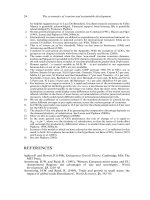THE ECONOMICS OF MONEY,BANKING, AND FINANCIAL MARKETS 359
Bạn đang xem bản rút gọn của tài liệu. Xem và tải ngay bản đầy đủ của tài liệu tại đây (46.26 KB, 1 trang )
CHAPTER 13
Banking and the Management of Financial Institutions
327
Suppose that both banks got caught up in the euphoria of the real estate market in 2006 and 2007, only to find that $5 million of their real estate loans became
worthless. When these bad loans are written off (valued at zero), the total value
of assets declines by $5 million. As a consequence, bank capital, which equals total
assets minus liabilities, also declines by $5 million. The balance sheets of the two
banks now look like this:
High Capital Bank
Assets
Low Capital Bank
Liabilities
Reserves $10 million
Loans
$85 million
Deposits
Bank
capital
Assets
$90 million
Reserves $10 million
Loans
$85 million
$ 5 million
Liabilities
Deposits
Bank
capital
$96 million
$1 million
The High Capital Bank takes the $5 million loss in stride because its initial
cushion of $10 million in capital means that it still has a positive net worth (bank capital) of $5 million after the loss. The Low Capital Bank, however, is in big trouble. The
value of its assets has fallen below its liabilities, and its net worth is now $1 million.
Because the bank has a negative net worth, it is insolvent: it does not have sufficient
assets to pay off all holders of its liabilities. When a bank becomes insolvent, government regulators close the bank, its assets are sold off, and its managers are fired. Since
the owners of the Low Capital Bank will find their investment wiped out, they would
clearly have preferred the bank to have had a large enough cushion of bank capital
to absorb the losses, as was the case for the High Capital Bank. We therefore see an
important rationale for a bank to maintain a sufficient level of capital: a bank maintains bank capital to lessen the chance that it will become insolvent.
HOW THE AMOUNT OF BANK CAPITAL AFFECTS RETURNS TO EQUITY HOLDERS
Because owners of a bank must know whether their bank is being managed well,
they need good measures of bank profitability. A basic measure of bank profitability is the return on assets (ROA), the net profit after taxes per dollar of assets:
ROA
net profit after taxes
assets
The return on assets provides information on how efficiently a bank is being run,
because it indicates how much profit is generated on average by each dollar of
assets.
However, what the bank s owners (equity holders) care about most is how
much the bank is earning on their equity investment. This information is provided
by the other basic measure of bank profitability, the return on equity (ROE), the
net profit after taxes per dollar of equity capital:
ROE
net profit after taxes
equity capital
There is a direct relationship between the return on assets (which measures
how efficiently the bank is run) and the return on equity (which measures how well
the owners are doing on their investment). This relationship is determined by the
equity multiplier (EM), the amount of assets per dollar of equity capital:









